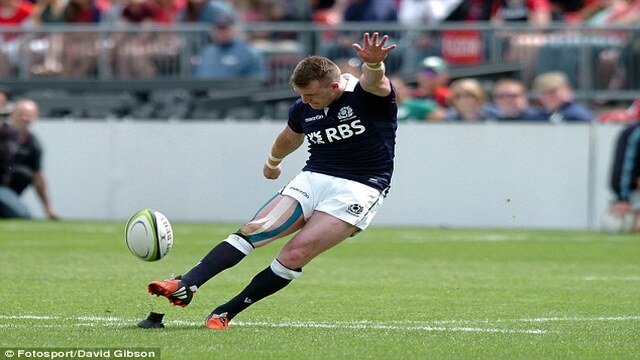Stuart Hogg’s Six Nations kick return against Ireland – related to Wayne Smith module counter attack from kick receipts part 1
In his excellent introductory module on counter attack, Wayne Smith outlines the basic principles of attack on kick returns. Those principles can be summarised as follows:
• Base your counter on the features of the kick-chase defence
• Look for the potential space & identify mismatches (e.g. the tight five forwards)
• Use of arcs and angled running to manipulate the defence
Towards the end of the recent Six Nations, Scotland scored one of the best tries of the tournament from a Stuart Hogg kick return in the final round against Ireland. In the process they used all of the features flagged up by Wayne Smith in his module on counter attack from opposition kicks.
Hogg’s try came from a box kick exit from the boot of Ireland’s half-back Connor Murray, watch it here.
Initially, let’s just say that there is a problem with both the length of the clearing box kick. It is a little too long at 31 metres, but more importantly, it doesn’t stay in the air long enough for the chase to put pressure on the Scotland receiver. The aerial hang-time is under 3.5 seconds, where four seconds or more is mandatory in the modern game.
This is the ‘first cause’ which sets the scene for Hogg’s return and the immediate result is that the first Ireland chaser (14 Andrew Trimble) is six metres shy of Stuart Hogg when he receives the ball, and has to back off rather than accelerate into the hit. This in turn affects the overall Ireland defensive line-speed for the worse.
From this point onwards, Wayne Smith’s core principles come into play:
• Base your counter on the features of the kick-chase defence. Ireland’s 1st phase shifted the ball all the way across field from a left-side scrum through the back-line chain, so the box kick is now on the ‘wrong’ side of the field. This means that the open-side is being defended by tight five forwards, with only the Ireland #13 Jared Payne having been able to regroup to book-end the far edge. When he looks up at 19:14, Stuart Hogg sees an inviting 20 metre block of space out to his right, defended by 5 Devin Toner on the near 15m line, then 1 Jack McGrath, 3 Mike Ross and 2 Rory Best out into midfield. So the features of the chase, with the front row defending as a group in midfield, determine the character of the counter-attack.
• Looking for the space & identifying mismatches. Hogg clearly identifies the potential mismatch, because at 19:16 he runs an arc at the middle defender of three Ireland front rowers grouped together, Mike Ross. However at this stage of the counter the target space is only potential, because the line-spacing between those defenders is tight, with no more than 6-7 metres separating the inside man of the three (1 Jack McGrath) from the front-rower on the outside, 2 Rory Best with the white hat.
• Use of attacking arcs and angled running. The key to opening up the space between the tight forward defenders is the presence of an option off Hogg, in the shape of 14 Tommy Seymour – and this is particularly obvious in the replay from behind the posts at 19:45. At that point (19:16/19:45), Best is firmly ‘eyes in’ on Hogg as he runs his arc on to Ross, and this temporarily keeps the gap between Best and Ross tight and stable. But as Hogg’s arc into midfield connects him with Seymour’s run from deep, Best suddenly has to consider the gap outside as Seymour veers away. His shoulders begin to turn out towards the far side-line one second later. We can clearly see Best’s head, in his white hat for easy identification, turn from Hogg on to Seymour at 19:17, and this is the crucial event in the sequence. Hogg’s arc and Seymour’s cleverly angled run have successfully manipulated the Ireland chase D to create a one-on-one where Scotland’s quickest back can run away from Ireland’s slowest front-rower.
Kick returns with this degree of accuracy are relatively rare birds in the Northern Hemisphere. Whether Stuart Hogg and his cohorts had been reading Wayne Smith’s article we will probably never know, although the presence of a Kiwi coach in Vern Cotter may have reinforced the same principles. The point is that the principles are there in black and white. Well-executed, they produce the perfect clean break from kick receipt.


